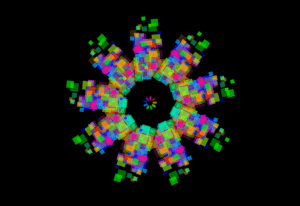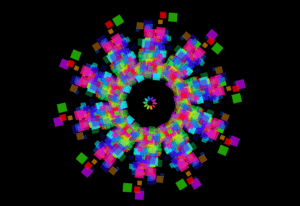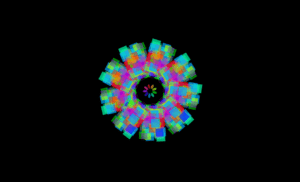Title Listen Behind
Project Description This project features an audio file that the participant should listen to with a pair of earphones (better if they are noise-cancelling) and a blindfold over their eyes (or they could simply close their eyes). It is expected to give them the feeling of scissors cutting off their hair, a plastic bag put overhead, tapes torn off their neck, etc. Through the sense of hearing, I would like to make the participant feel that they are touched by some specific object, or that the noise they hear is generated right behind them. Simply put, I believe hearing could evoke the sense of touch, and I want to distort the participant’s judgment of distance with sounds. I was inspired by a 3D audio called “Virtual Barber Shop” I heard a few years ago, in which you can hear a man speaks and does things to you in a way that makes you feel like he is actually next to you.
Perspective and Context According to The World of Perception, in classical physics, “an object is a system of properties which present themselves to our various senses and which are united by an act of intellectual synthesis” (Merleau-Ponty, 59). An object is something that fills some space, but through this project, I was trying to distort participant’s perception of space. Usually, a person perceives space through his vision and hearing. The fact that humans have two eyes and two ears enables us to determine distance through vision and hearing; to put it in another way, that’s how we perceive space. As stated in the quote, we perceive objects using multiple senses – especially vision and hearing, so what happens when one’s vision is hindered? They get more sensitive in terms of the ability to tell the position of an object through listening to the sound it makes.
Another ability is also required in order for my project to work as expected – the one to know what an object is through its sound. This depends on the common knowledge between me and the participant, and both different cultural backgrounds and lifestyles could have impact on that. Nonetheless, even if the participant can’t tell what it is by just listening to the sound it makes, they are still able to experience the project just fine, as long as their brain tells them where the sound is from. Thus this project was somehow similar to the concept of virtual reality, except for the fact that I took out visuals.
Development & Technical Implementation I used a Tascam recorder I borrowed from IMA Equipment Room to do all the recording. With two adjustable microphones on the top, the recorder easily captures authentic stereo sounds. I recorded over ten sounds in total, ranging from the noise of plastic bag to clock ticking.

Then I edited the five audios I selected with Audacity on my laptop, giving them a fade-in/fade-out effect and putting them all in one file, whose run time is 4 minutes and 35 seconds. Because of the high quality, the file is 46 megabytes large. The five sounds that made it to the final cut are: the noise of plastic paper, the sound of an electric toothbrush vibrating, the sound of scissors cutting a napkin, the sound of plastic bag, and the sound of tearing off a piece of tape.
Below is a compressed version of the audio. (Put on earphones before listening!)
Presentation In class, I presented my project to a classmate, Ivy. Since I needed my phone to play the audio, I did not take any picture or video of her experiencing it. I did not talk much about what my project was, but instead requested silence in the room and let her sit down and put on the blindfold. Then I gave her the earphones, and after she put them on, I started playing. During the four and a half minutes, she didn’t display many facial expressions. Afterwards, she described how the sounds gave her visions of different colors, which was quite unexpected. Then I explained my purpose of the project, and she seemed a little surprised and was uncertain if it achieved what I intended.
I had a few assumptions about why it failed to produce the expected effect in class, the first one being that the earphones were not plugged in place. I actually noticed during presentation that the earplugs were loosely placed by Ivy’s ears, but I chose not to remind her because I didn’t want to interrupt the experiencing process. However, now I realize that it is crucial to my project that the participant puts on the earphones properly. Secondly, I assume that the participant gave me feedback that I hadn’t expected because she did not know what to expect. As many of the projects shown to us focused on twisting vision and hearing, it is possible that Ivy was actually expecting my project to evoke some visual feelings, which is why she concentrated on that, but not the sense of touch I intended to create.
After class, I tested my project again on Lily and Candy, to both of whom I explained what my intention for the project was, and they showed stronger reactions.
Conclusion One of my major realizations is that for the presentation, I should have elaborated a little bit on the intention for the project, and then played it, so that the participant knew what to expect and would focus on the effect I was trying to get at. In fact, I intentionally left out the introduction, because I did not want it to interfere with the participant’s first-time experience, which now proves to be not so good an idea. Another way to think about the failure of the presentation is that maybe the effect that my project was intended to produce was not strong enough – in which case I could try to come up with some ways to enhance the 3D sound effect. I googled it, and there were quite a few software programs that do the job, one of which is Adobe Audition. That maybe an option for me if I wanted to create some kind of immersive ambient sound next time. 3D surrounding sound effect is a vital element for a virtual reality experience as well, so this project could be of good value if I were to delve into that direction in the future.


